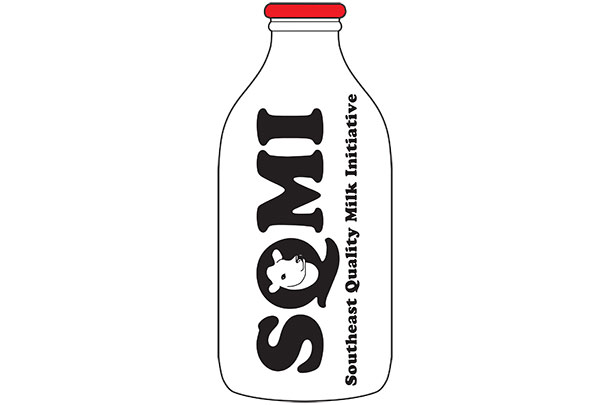Milk quality in the southeastern region of the U.S. has historically been worse than the rest of the country. Resolving this issue is imperative in order to maintain sustainability in the region. The Southeast Quality Milk Initiative is a multi-state collaborative outreach, educational and research program aimed to improve the sustainability of dairy production in the southeast region of the U.S.
Milk quality professionals from four land-grant universities (Mississippi State University, University of Kentucky, University of Tennessee and Virginia Tech) visited farms to evaluate management practices, facilities and equipment required to control mastitis.
The primary goal of this project was to characterize which management practices employed by producers were most highly associated with a low bulk tank somatic cell count (SCC) in this region of the U.S.
Two hundred eighty-two farms were visited (96 in Kentucky, 83 in Tennessee, 96 in Virginia and seven in Mississippi). A 175-question survey was answered on-farm by each farm’s primary decision-maker to evaluate dairy management practices.
Herds were categorized as low (less than 190,000 cells per ml), medium (between 190,000 and 260,000 cells per ml) and high (greater than 260,000 cells per ml) SCC groups based on 2013 bulk tank SCC reports. Ninety-five low-SCC, 94 medium-SCC and 93 high-SCC herds were evaluated.
To account for effects of season, visits were distributed throughout the year. Herd size ranged from 32 to 2,500 lactating cows with a median of 125 cows. Most producers owned multiple breeds of cattle, but almost all herds included Holsteins. Some results of this project are summarized in this article.
Most producers visited for this project were between 46 and 55 years old. However, high-SCC producers were also heavily represented in the 56- to 65-year-old and 36- to 45-year-old categories. Medium- and low-SCC producers were heavily represented in the 26- to 35-year-old category. Most producers in all SCC groups had a college degree.

However, more high-SCC producers did not finish college or technical school compared to medium- and low-SCC producers. Most producers involved said their farms would “almost certainly” be in operation in both five and 10 years from now, meaning they are all somewhat optimistic about the future of the dairy industry in the Southeast.
Most herds in all SCC groups were mostly confinement (less than four hours of outside access per day). However, more high-SCC herds were exclusively pastured than medium- or low-SCC herds.
Because of this, high-SCC herds used a grazing-with-supplementation feeding system more often than low- and medium-SCC herds, which usually fed a primary TMR-based system. Most rations did not include feed additives to manage SCC.
Regardless of SCC group, most facilities were built before 1995 and had not been renovated since. Producers of low-SCC herds tended to house high-SCC cows away from the rest of the lactating herd, even if they were not being treated. However, medium- and high-SCC herds usually housed high-SCC cows with the lactating herd.
Housing high-SCC cows away from the rest of the lactating herd may help prevent the spread of contagious mastitis, particularly if the high-SCC group is milked last.
Fans were available in both the parlor and housing facilities in most evaluated herds irrespective of SCC. Low- and medium-SCC producers turned on fans most commonly at 75ºF, whereas high-SCC producers waited until 80ºF. Cows start to experience heat stress at a THI of 68ºF, and dairy advisers usually recommend turning on fans before the temperature reaches 75ºF.
Most producers involved in this objective said they observed at least a portion of every milking, even if they were not the ones doing the milking. Managers of high-SCC herds thought a bulk tank SCC of 400,000 cells per ml was the point at which action should be taken to reduce the bulk tank SCC.
Interestingly, medium-SCC producers took action at 300,000 cells per ml and low-SCC producers took action at an even lower 200,000 cells per ml. Waiting to troubleshoot may limit possible solutions and may require dumping milk in order to reduce the SCC enough to sell the milk.
Producers of low-SCC herds started troubleshooting and taking action if less than 5 percent of their herd had clinical mastitis. Producers of medium- and high-SCC herds started troubleshooting and taking action if 5 percent of their herd had clinical mastitis. These results imply that low-SCC producers try to resolve mastitis problems sooner than medium- and high-SCC producers.
Interestingly, more medium- and high-SCC producers called a veterinarian for clinical mastitis than did low-SCC producers. Most producers involved had regularly scheduled vet visits throughout the year.
It is plausible that low-SCC producers asked their vets to examine cows during these routine visits before the mastitis became severe, enabling the cow to be treated sooner or monitored more closely, and thus preventing the producer from having to call the vet out for a special trip. However, this is only speculation.
Most low-SCC producers stripped quarters more frequently when a cow had clinical mastitis to evaluate the cow’s improvement. Most medium- and high-SCC producers dried off cows early if they were unresponsive to treatment, which was not the case for low-SCC producers.
Many factors contribute to maintaining a low SCC. Many management systems, herd sizes and SCC levels were represented in this study. These results suggest that a low SCC can be attained on any farm as long as it is managed properly.
Dairy producers often make decisions based on what other producers in their area are doing. Therefore, dairy producers and industry advisers in the Southeast may use these results to help reduce SCC in the Southeast. PD
Visit sequalitymilk.com for more information on the Southeast Quality Milk Initiative. This work was supported by a grant award from USDA-NIFA-AFRI (2013-68004-20424).
Chandler Blakely, Mickayla Myers, Kerri Bochantin, Peter Krawczel, Christina Petersson-Wolfe, Gina Pighetti, Stephanie Ward and Jeffrey Bewley contributed to this article.

-
Amanda Stone
- Graduate Extension Assistant
- University of Kentucky
- Email Amanda Stone






